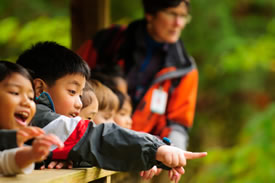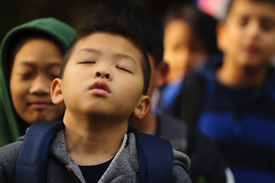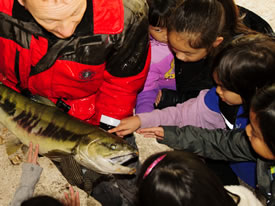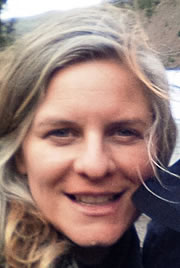Makes me wonder: Nature firsts

Students from John Norquay Public School, Nature Days Vancouver (Photo by HSBC Bank Canada)
When it comes to the natural world, there is something remarkable about first times. On the doorstep of discovery is a story taking form, one that eventually settles into memory and becomes part of who we are and how we come to know the places that matter to us. With each bird’s nest sighted, fish hiding in reeds, that surprising osprey diving for trout just off the deck of your kayak or a cinnamon bear scampering to high land in the foothills, the world becomes a little bit bigger, and a little more personal.
I remember the first time I knelt down and peered into an intertidal pool. It was in Rennell Sound, on Graham Island’s western coastline in Haida Gwaii, British Columbia. It was sunny that day; a high-pressure front was clearing clouds for sunshine and the tide was out. Scrambling across the rocky outcroppings, I leaned into tidal pools, peered into crevices and cracks full of life — all within a hand’s, an eye’s, reach. A riot of colourful determined species tucked in and stuck to rock; resiliency at its finest. Crabs, limpets, snails, sea cucumbers, whelks and chitons forming a startling assemblage of life for an easterner who grew up alongside fresh water rivers and streams.
I was amazed. I was hooked on finding out more about these places, these creatures. I was motivated by that string of moments.
I have a lot of faith in curiosity and wonder, believing in its ability to inspire across disciplines; a propelling practice in itself for all of us, of all ages.
Encountering the tide pools at Rennell Sound took place 15 years ago; it was my 28th birthday. These thoughts came to me while I witnessed wonder emerging along the banks of the Cheakamus River near Squamish, BC this November. I was spending the day walking with a group of elementary students out to learn first-hand about salmon forests and the nutrient cycle that leads to the robust ecosystems of the Pacific west coast.
Twenty-two Grade 3 students from east Vancouver’s John Norquay Public School joined Nature Conservancy of Canada (NCC) and HSBC Bank Canada staff at the Cheakamus Centre — an outdoor education centre owned by the North Vancouver School District on lands where NCC holds a covenant. The outing was part of NCC and HSBC Bank Canada’s Nature Days program, which is designed to connect urban youth with nature.
It was a day of many firsts, for many.
In the company of Conor Mcmullan, director of educational programs and Kate Keogh, vice principal at Cheakamus Centre, children walked along the streamside trails and adjacent forests, which were littered with chum remnants. The salmon had been pulled up out of the river by bears, feasted upon and then left for eagles and other birds and other mammals. In time, they will decay into organic matter that supports the growth of plants and trees.

Stopping to breathe and take in nature. (Photo by HSBC Bank Canada)
The buildings that make up Cheakamus Centre are surrounded by old forests where you can close your eyes and breathe in all that surrounds you.
“I bet there isn’t any technology,” said one little boy. “I don’t think there is any internet here,” he said, ambling along the trail towards the hatchery. The centre also supports an operational salmon hatchery for chum and coho, providing a real-life lesson about the salmon lifecycle.
For most of the children, this was the first time they'd ever seen a real salmon, dead or alive, let alone touched one. For them all, it was the first visit to Cheakamus.

HSBC Nature Days, Vancouver, 2014 (Photo by Tim Ennis/NCC)
"A week after our Nature Days event, the children were still bubbling with excitement, learning and curiosity — lots for the classroom teacher to build upon into the school year," says Margaret Jorgensen, principal, John Norquay Public School.
After the event, some of the children shared their memories from the day:
“The salmon was huge and so slimy!”
“There were so many salmon on the shore — the bears feed on the salmon. I’m glad I didn’t see any bears!”
“I got to touch the salmon and the animals!”
...not to mention...
“I’ve never had chili before! I loved it and the rice too!!” (thanks Chef Wade! You never know when a first will happen...)
The role of salmon in building the forests of the Pacific Northwest is iconic natural process. I hope this Nature Days event helped make these connections real, giving the children from John Norquay Public School a story they can carry with them and share with their family and friends. If it forms a personal point of curiosity in nature, and by extension conservation, then perhaps these children will contribute to caring for these places and species.
"It is generally agreed that people care about what they know and understand," says Mcmullan. "This is a guiding principle for the experiences that we facilitate at Cheakamus Centre’s Outdoor School. Creating connections between students and a specific living thing helps build this sense of awareness and emotional attachment that helps students to develop a foundation of empathy and understanding about and for the natural world.
"Whether it’s through direct experiences with spawning salmon and the eagles that feed upon them, or a 1,000-year-old red cedar, these connections help students to care about nature and give consideration to their place within it."
From the spawned-out salmon littered across the trails to a close-up with a male chum captured and released after contributing to next season’s native stock at the hatchery, the children experienced what I hope are meaningful firsts, adding a bit more to their own personal story of what nature means to them and their lives.
How can we hope for this if we do not show and share?
Can you recall your first nature wonder moment, when feelings of awe turned to curiosity about the natural places that matter to you? How did it inform your nature story? Please share with us in the comments section below...


